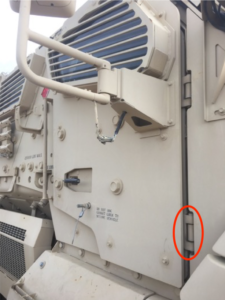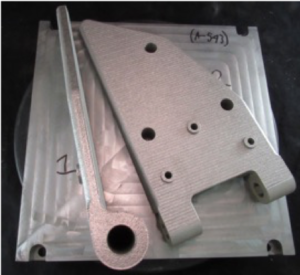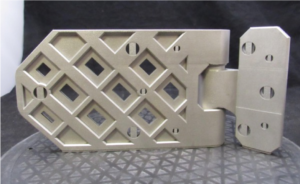Accelerating Additive Process Qualification with Redesigned Hinge Replacements
In 2007, in response to a growing threat of IEDs (improvised explosive devices) in the Iraq War, the U.S. Department of Defense began a program to produce Mine-Resistant Ambush Protected (MRAP) light tactical vehicles. At some point, in response to changing threats in the field, the cab doors were modified to add a 400-lb. armor plate to the existing 800-lb. design to better protect people inside the trucks.
Unfortunately, this up-armoring added weight that tested and often exceeded the strength of the doors’ hinges. In some cases, the hinges failed while on base. In other instances, doors fell off in the field while on patrol in Afghanistan and Crimea, leaving soldiers to figure out how to reattach a 1,200-lb door to get themselves and their vehicle back to safety.
 Hinge failure could take the vehicle out of commission for an extended time – as long as two years – while replacement hinges from the original equipment manufacturer (OEM) were procured, delivered and installed through the traditional supply chain. At times, the valuable vehicles would need to be transported back to the U.S. at great expense to complete the repair. That led TARDEC, the U.S. Army’s Tank and Automotive Research, Development and Engineering Center, to seek an alternative supply for replacement hinges. TARDEC brought the challenge to the ADAPTSM Center, and together with its members and partners, ADAPT used data-driven additive manufacturing (AM) to reproduce and ultimately redesign the hinges.
Hinge failure could take the vehicle out of commission for an extended time – as long as two years – while replacement hinges from the original equipment manufacturer (OEM) were procured, delivered and installed through the traditional supply chain. At times, the valuable vehicles would need to be transported back to the U.S. at great expense to complete the repair. That led TARDEC, the U.S. Army’s Tank and Automotive Research, Development and Engineering Center, to seek an alternative supply for replacement hinges. TARDEC brought the challenge to the ADAPTSM Center, and together with its members and partners, ADAPT used data-driven additive manufacturing (AM) to reproduce and ultimately redesign the hinges.
An ADAPT partnership of Colorado School of Mines, Elementum 3D, Citrine Informatics and Ft. Carson worked with TARDEC and the Air Force Research Laboratory to first replicate and characterize the fatigue performances of the direct replacement parts made using AM. The knowledge gained from that initial phase of the program informed a redesign of the hinge using design for additive principles, which reduced the number of parts in the hinge assembly from six to one and reduced the maximum stress in the hinge joints from 900 MPa to below 90 MPa (an order of magnitude increase in the factor of safety). Then, in the final stage of the program, ADAPT partnered with Professor Albert To at the University of Pittsburgh to optimize the geometry of the designed-for-AM hinges, which reduced their weight by 38% relative to the original hinge assemblies.
 This collaborative process took a data-driven approach that showcased the strengths of the ADAPT Consortium. Using preexisting data from other ADAPT projects already in the adapt.citrination platform, the team was able to predict the quality of the replacement part, which was built using a completely new material/printer combination. The result was an 84% accurate prediction of build parameters on the first print, which simply replicated the design of the existing OEM hinge assembly. Then, the group was able to focus on how to create a simpler, lighter hinge, not just a direct replacement.
This collaborative process took a data-driven approach that showcased the strengths of the ADAPT Consortium. Using preexisting data from other ADAPT projects already in the adapt.citrination platform, the team was able to predict the quality of the replacement part, which was built using a completely new material/printer combination. The result was an 84% accurate prediction of build parameters on the first print, which simply replicated the design of the existing OEM hinge assembly. Then, the group was able to focus on how to create a simpler, lighter hinge, not just a direct replacement.
Using a design/build strategy that incorporated new modeling, simulation and experimental test data into the adapt.citrination database, the team was able to quickly produce quality specifications for temporary or permanent replacement parts. This feedback method – build, test, then use machine learning to evaluate and update the build – can significantly reduce development and qualification time. Testing verified that predicted settings like build direction and build speed produced a final product that meets or exceeds the performance required in the field in terms of strength, weight and durability.
 The final hinge design, significantly stronger and lighter than the OEM hinges, eliminated the failure problem under the 1200-lb load and is a direct one-piece replacement that uses the same bolt pattern. A set of MRAP hinges built using ADAPT’s Optimize for AdditiveSM strategy are ready for ground vehicle testing by the Army in mid-2019.
The final hinge design, significantly stronger and lighter than the OEM hinges, eliminated the failure problem under the 1200-lb load and is a direct one-piece replacement that uses the same bolt pattern. A set of MRAP hinges built using ADAPT’s Optimize for AdditiveSM strategy are ready for ground vehicle testing by the Army in mid-2019.
Key improvements from the original OEM hinge include:
- Single-piece design vs. six pieces for the OEM part
- Significant increase in strength to avoid the breakage the OEM hinges were suffering
- Part design that can be printed on demand, requiring no inventory
- Quicker part fabrication and delivery – the redesigned hinge can be printed in 24 hours and finished and delivered in days – not weeks, months or years
Through collaboration and the application of data-driven Optimize for Additive methodologies, ADAPT met the challenge of qualifying an AM process for ground vehicle part replacement by producing parts ready for ground testing, all within one year.




